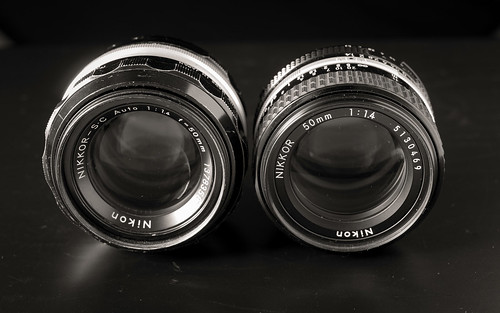Living where I do, I absolutely know much how fortunate I am to live in peace. There is mental space and physical safety to do the things I want, like write these little amount to nothing important blog entries.
Not everyone has this option these days. We receive daily reminders of this fact and it's downright heartbreaking. People are being killed for a man's out-sized sense of power, control, and entitlement. I wish peace for everyone.
Here is what Peter Turnley has been doing in the Ukraine. Here are some of his photos.-------------------------
In a prior post I noted that the AiS version I have of a Nikon Nikkor 50mm f/1.4 exhibits a magenta color shift in broad/large high contrast transition areas.
Since the comparison images didn't quite match to my liking, I wondered how strong the color shift really was and I felt I needed to have another look at things.
I did this by taking the Rawtherapee "Auto Tone Matched" Nikon Nikkor-S.C 50mm f/1.4 image as the image to be matched and tried to process the AiS f/1.4 to match it as closely as I could.
It seemed that if both lenses suffered from similar amounts of color shift in the extreme highlight to shadow transition areas that by rising the highlights to look like the S.C output that maybe, just maybe, the AiS color shift would diminish, if not outright disappear.
On the other hand, if the AiS' color shift was still present after doing what I could to match the luminosity of the two images, then I would be observing a real difference between these two double Gauss designs, or at least between the two individual samples I have on-hand.
Further, if there was a difference, what would it look like in a human perception model color to black and white conversion? I ask this because it is easy to see differences in colors of similar energy levels, but when converted to black and white certain out of focus effects change, to my eyes, for the better. Said another way, we can see color changes across an out of focus disk, but if they are of the same energy level then the disk becomes even and flat when converted into black and white.
Setup -
- Sony A7 - ISO100, +1EV, 2 second timer, in-camera levels used to square the whole plot up
- Manfrotto tripod - it's capable of securing an 8x10inch view camera, so it's sturdy enough for this
- Lenses -
- Nikon Nikkor-S.C Auto 50mm f/1.4 pre-Ai
- Nikon Nikkor 50mm f/1.4 AiS
- Rawtherapee RAW to jpg conversion - Auto-Match function, AiS image processed to match the S.C photo by +3 Lightness, -10 Contrast
Comparison -
Here is the scene setup. It's just a pair of closed gaze scrims in our apartment. The details are interestingly small, so therefore useful for this kind of "wee look-see."

[As always, click on the image and look at it to 100percent file size to see whatever there is to be seen.]

Comments -
Note: Please keep in mind I'm comparing single examples of lenses. It's not like I have a deep repository of samples and examples of all these optics. What I see in the lenses in my possession might not be seen in other people's copies. And, as with my Lens Turbo II studies, not all effects are attributable to the primary optic.
Looking at the two lenses shot wide open, the AiS' magenta color shift is still visible after processing the image to more closely match the S.C. The Nikkor-S.C image still looks good to my eyes.
Is this chromatic aberration in the AiS version? Is this some effect of light bouncing off the sensor back into the lens back through the sensor? Or is it something else entirely? I'm not yet sure what it is. Nor am I sure it would make much difference when photographing under less contrasty situations. The contrast is rather extreme in this comparison.
The human perception color to black and white conversion is rather interesting. I see no trace of the color shift converted to either lighter or darker gray tones, as both AiS and S.C images look equivalent.
So what do I have here? I'm not entirely certain. There must be other ways of looking at this, including recognizing the fact that the AiS design was used (if the internets are to be believed) in the AF-D 50mm f/1.4 Nikkor. If the implementation is good enough for the AF lenses (yes, I realize there is a more recent G version), perhaps there's really nothing wrong with the lens I have? Maybe I'll have to go out and photograph with these two Nikkors and see how they behave in the outside world?
I'm chasing pixies. Pixies, I tell you.

No comments:
Post a Comment